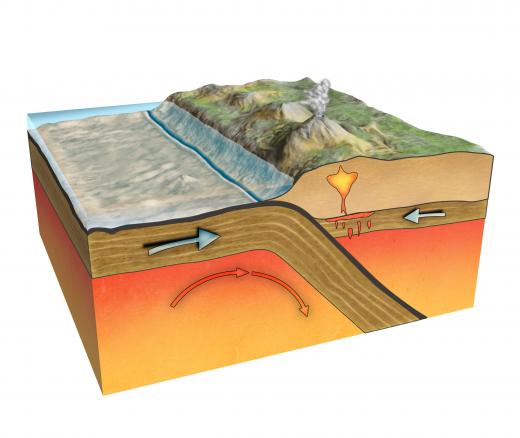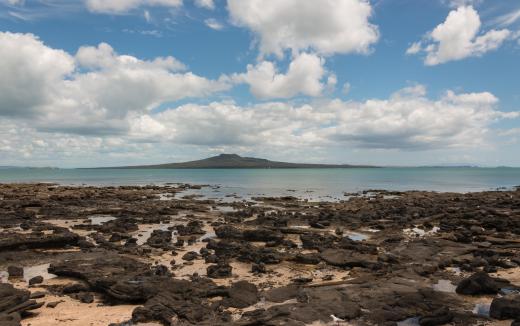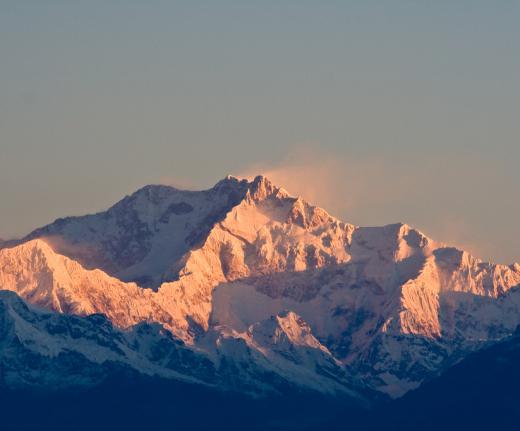What is a Subduction Zone?
A subduction zone is a convergent boundary where two tectonic plates collide. Plates are large, dense masses in the crust of the Earth, the lithosphere, that float on top of liquefied rock in the asthenosphere. They are constantly shifting and moving, so when they subduct, one pushes beneath the other. These zones create geologic formations such as mountain ranges, ocean trenches, and island arcs, as well as phenomena like earthquakes and volcanoes.
Tectonic plates are categorized as either oceanic plates that have large bodies of water above them or continental plates that support land. Geologists have learned about how subduction works by studying earthquakes in seismology and volcanoes in volcanology. They know that younger plates are less dense than older plates. Generally, ocean crust is thinner and denser than continental crust. Subduction zones don't only make certain landscape changes, but they recycle rock by melting it into magma so that crust might form at other tectonic zones.

When two oceanic plates meet, a deep underwater trench forms where the thicker plate plunges beneath the thinner one. At first, great pressure at the thrusting plates causes earthquakes. These open up spaces to the hot, molten magma so it can push through in submarine volcanoes. Eventually, the material builds up in a crest until it breaks the surface of the ocean, forming island "arcs" and archipelagos. This is how the Philippine Islands originated.

An oceanic and continental plate meet under different circumstances. Beneath the coast, their convergence causes the ocean plate to plunge underneath the continental one, piercing the hot athenosphere. Again, the first stage builds up pressure and releases earthquakes, which is why the Pacific "Ring of Fire" experiences so many tremors. Then, over time, mountains form on land as the continental plate buckles. The Andes are one such mountain range.

Two continental plates can also converge, but this might not technically form a subduction zone. Land crust doesn't have sufficiently different densities or thicknesses for one to be subducted. Still, it bulges and forms interior mountain ranges without volcanoes, such as the Himalayas.
Together with divergent zones, convergent zones ensure that the surface area of the earth never grows or shrinks. As the leading edge of the lithospheric plate is devoured when it melts in the hot athenosphere, the trailing edge forms out of cooling rock. Sometimes, smaller plates may entirely disappear, eaten by the magma.
AS FEATURED ON:
AS FEATURED ON:















Discussion Comments
What type of earthquake would you expect to find in a subduction zone?
How are tsunamis created in a subduction zone? What is a spreading zone?
what are island arcs?
@ ValleyFiah- In plate tectonics, subduction zones form oceanic trenches. The oceanic plates forces the continental plate down, and where they meet is characterized by a deep trench.
Deep ocean ridges are formed by divergent boundaries. The plates pulling apart open up a rift for magma to escape, causing the ridges that run through the deep ocean in areas like the Mid-Atlantic.
Divergent boundaries on land form the majestic mountain ranges typical of the Cascades and the Himalayas. The less dense continental plates collide, pushing each other up skyward.
Does anyone know if subduction zones create trenches or ridges? I would think that they would create ridges because the ocean plate is moving underneath the continental plate causing the continental plate to be pushed up, but I am not so sure about this. Can someone give me a decent explanation of this?
@ Anon26586- The most common type of volcano formed around a subduction zone is a volcanic arc. On these volcanic arcs are stratovolcanoes that erupt very violently. Volcanic arcs happen above the area where the oceanic plate has subducted to a depth of about 100 kilometers below the continental plate. At this depth wet melting occurs.
The process of wet melting occurs when water subducted below the surface turns to superheated steam, melting the sediment on the subducting plate and forcing it upward through the continental crust. This forms an island chain off the coast like the Indonesian chain and the Aleutian chain. This also creates a back arc basin that separates the island chain from the mainland. This back arc basin is filled with a sedimentary wedge, and is characterized by shallow waters relative to the deep ocean.
What type of volcanoes occur at subduction zones?
Post your comments